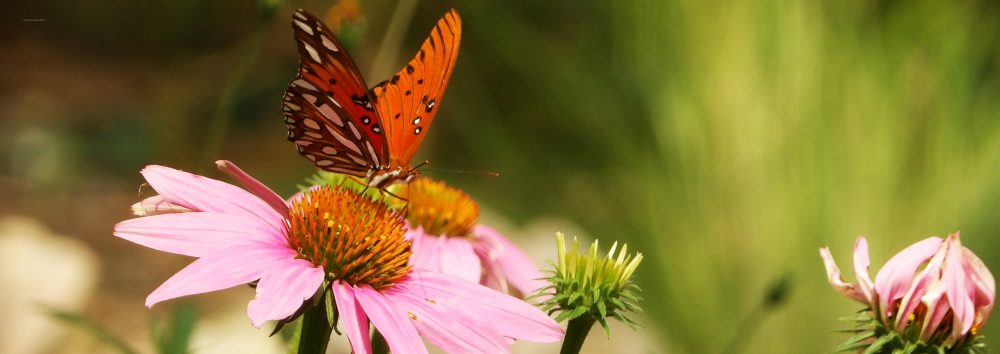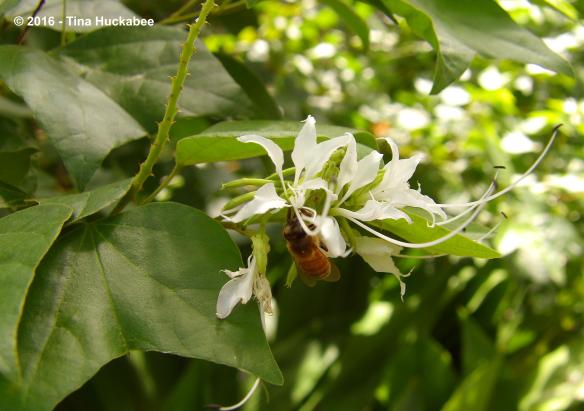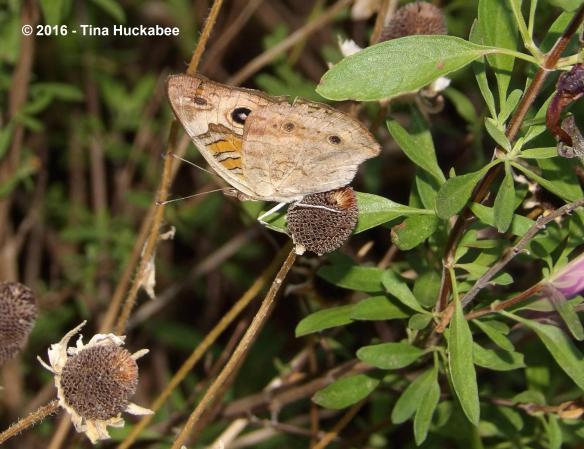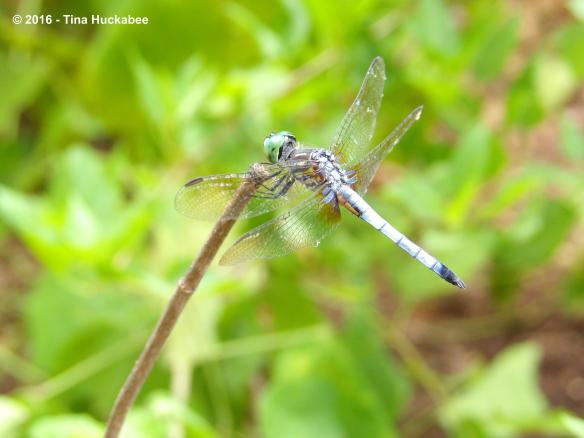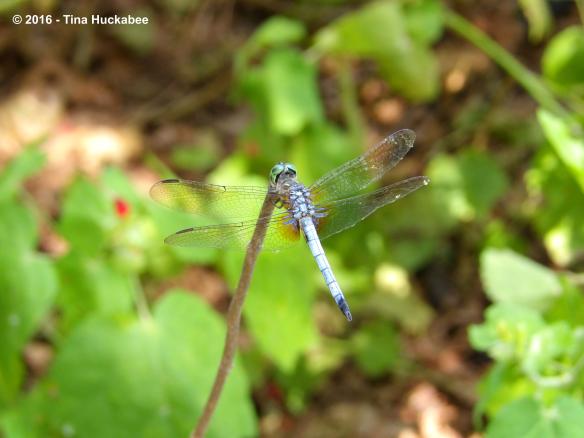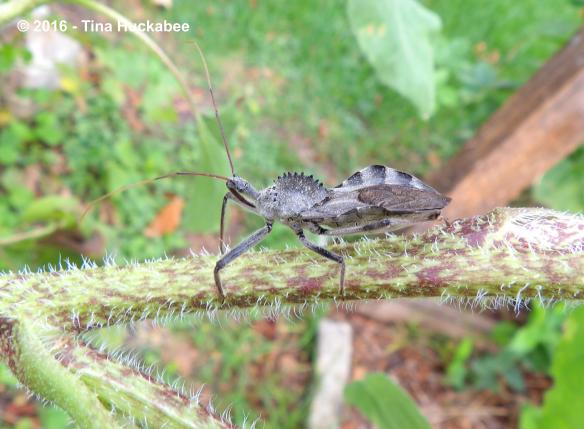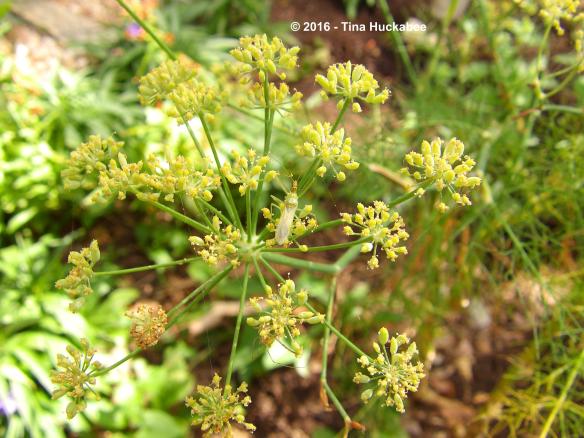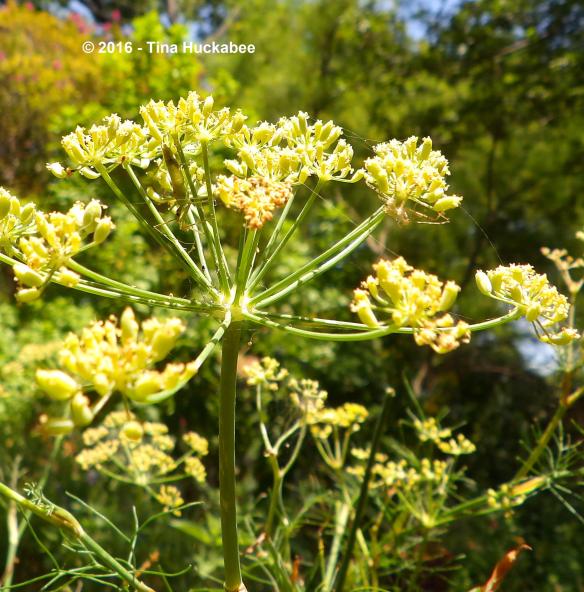Welcome to Wildlife Wednesday for August–and a toasty one it is. July definitely felt like the dog days of summer had arrived: it was hot and dry, with the relentless, searing Texas sun beating down mercilessly. Weirdly, that didn’t keep me out of the garden–I’ve been tweaking and transplanting in the garden all summer. Truthfully, it’s not as hot as recent summers, though it’s been humid owing to the generous spring–and some late July– rain.
Because of the pond and bird bath water available, wildlife in my garden has been active and varied, though only (it seems) when I don’t have my camera at the ready. Regardless, I’ve enjoyed observing Dad Northern Cardinal, Cardinalis cardinalis, feeding his fledged chicks, but never nabbed a shot of the charming familial activities. The Little Boy Cardinal, all scraggly and awkward, is cute:
But I don’t have any photos of Little Girl Cardinal, though often see both siblings pecking seeds alongside one another on the ground.
I see the odd Carolina Chickadee, Poecile carolinensis, snitching seeds from the feeder, but more often, I hear one announcing his territory. It’s always fun to observe and hear them–big songs out of tiny birds.
The Chickadees’ pals, Black-crested Titmice, Baeolophus atricristatus, dash in for their share of seeds, taking turns with the Chickadees as they feed while dodging the gluttonous White-winged doves.
The bird baths and pond have hosted a steady stream of visitors sipping and cooling off, like this joyful bathing Blue Jay, Cyanotta cristata .

Announcing her intention of bathing, she’s making it clear that there will be no sharing of the bath.
I don’t think there’s a bird species anywhere that relishes a splash-in-the-bath more than these beautiful guys-n-gals.
Earlier in the month, I fretted about the lack of Lesser Goldfinches, Spinus psaltria, nibbling at the sunflower seeds. I’m fairly sure I rankle a neighbor (or two…) when I don’t immediately prune done-with-flowering plants according to human sensibilities of beauty. But I’m glad I don’t prune because this past week, a little crew of Lessers arrived to partake of the sunflower seed buffet!
Chatty and determined to eat their fill, I love watching them bop around the plants as they munch away. Lesser Goldfinches, as well as other bird species, enjoy seeds from a variety of perennials in my gardens. In the fall, I’ll see another round of these cuties dining on the Plains Goldeneye seeds–it’s something to look forward to. Enjoy your beautiful blooms, but once the blooming is done, leave the spent blooms to develop nutritious seeds for birds: they’ll visit your garden and you’ll enjoy the show. After all, that’s what seeds are for–to feed wildlife. Plants may look messy for a short time, but the pleasure of watching a variety of birds feed is well worth the short-lived untidiness of the plants, plus you’ll be adding to the health of your endemic wild critters.
Honeybees have had plenty to nectar on and pollen-gather from this summer.
Native bees are busy at their work. This tiny bee (Perdita ignota?) and her friends have been all over the also tiny florets of an oregano,
…while these two mating Horsefly-like carpenter bees, Xylocopa tabaniformis,
…bring a new meaning to the term multi-tasking, as they flew “entangled” while nectaring on Mexican Honeysuckle blooms.
No bee here, but instead, evidence of a busy mama leafcutter bee sawing off bits of leaves to pack into her nest for her little bee-ones.
I wish I could have watched her work.
Moths and butterflies are occupied, too. Pretty-in-pink is this Southern Pink Moth, Pyrausta inornatalis, resting on a Henry Duelberg Sage.
I was lucky late one afternoon to spy a Common Buckeye, Junonia coenia.
Buckeyes are common–except in my garden, though I grow several species of Ruellia plants which is one of this species host plants. I guess I need to keep a keen eye out for eggs and/or caterpillars on the Ruellia. Stunning in color and patterns, the males will perch on plants scanning for females–maybe this one was looking for a mate?
At any rate, he posed nicely and I hope he met a nice girl.
It isn’t July–or summer, for that matter–without the dragonflies. This jewel-like Blue Dasher, Pachydiplax longipennis, demonstrated patience with my photo taking .
I saw him land, went inside the house to get my camera and promptly was distracted by something shiny. Later (at least 10 minutes later), I remembered why I came into the house (please tell me that happens to you!). I grabbed the camera, headed back out and Mr. Gorgeous was graciously waiting for me. I guess he REALLY wanted to appear in this month’s Wildlife Wednesday.
There are plenty of other dragons and damsels in the garden, mostly because there are several ponds in the neighborhood. They’re excellent predators for mosquitoes and who can complain about that? Go get’em, dragons-n-damsels!
Speaking of predators, the assassins are active, as well as being some of the coolest looking bugs around. The Wheel Bug, Arius cristatus, is looks like he just exited from a space ship.
Both males and females have the toothy-wheel protuberance on their thorax, though the exact purpose of this crest is not known. Probably it’s to freak out everyone.
Actually, these beneficial insects are quite shy and don’t seek conflict. Of course, that’s true of most insects–and other wildlife. Wheel Bugs and their kin feed on aphids, caterpillars and other assorted insects and thwart predators with their stinky essence.
A related assassin bug is this Zelus luridus.
I observed him (her?) lurking about on the developing seed heads of a fennel plant.
Another was perched on top of the plant,
…but later in the day, during mid-afternoon when it was very hot, this smart one decided to use the seed umbel as an umbrella and crawled underneath for some shade.
I’m fairly sure that I spied this one was holding an iddy-biddy umbrella drink in its claws.
A good idea, if you ask me.
A day or two before, I’d seen another assassin (or maybe the same?) with a hapless and stunned little native bee in its grips. As I leaned in for a closer look, the predator winged to the ground, with prey “in hand.” Assassins prey on all soft-bodied insects, including some of the good ones.
Late July saw the dog days disrupted briefly with a gift of gorgeous, soaking rain. Woo-hoo!! The reprieve from summer’s heat didn’t last for long though and August is always tough here in Texas. Alas, autumn is just around the corner.
Until next month…
Did wildlife visit your garden this past month? Please post for August Wildlife Wednesday. Share the rare or mundane, funny or fascinating, beneficial or harmful critters you encounter. When you comment on my post, please remember to leave a link to your Wildlife Wednesday post so readers can enjoy a variety of garden wildlife observations.
Happy wildlife gardening!
